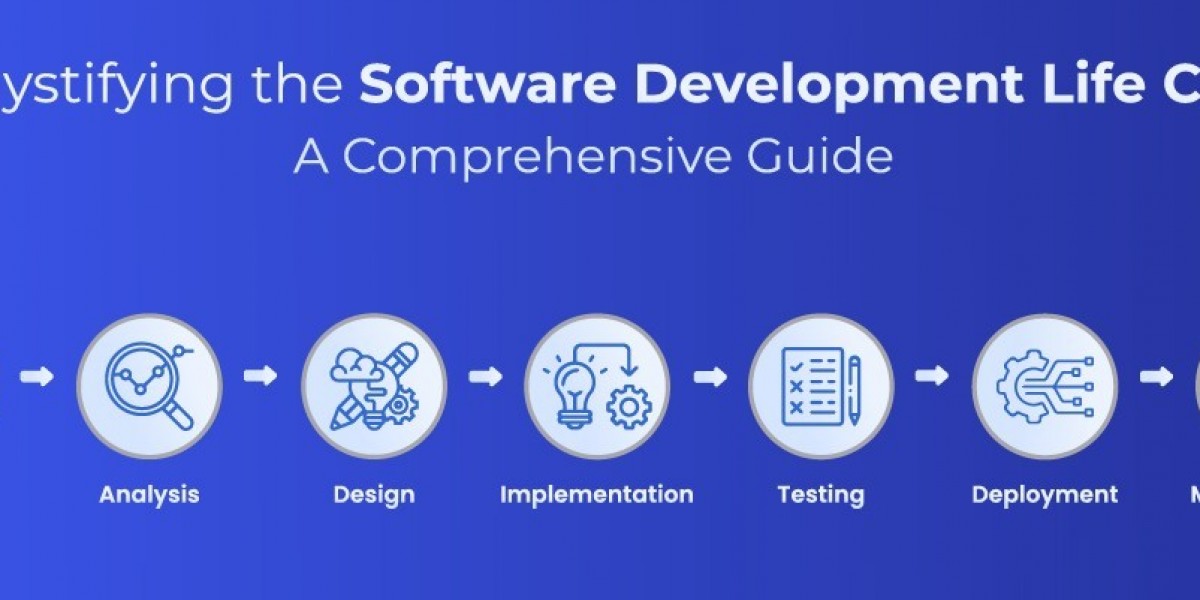The Software Development Life Cycle (SDLC) is a structured process for software development used by the software development teams to produce high-quality, low-cost software in the shortest possible time. Software development companies use this systematic approach to complete the project efficiently, on time and within budget while meeting the needs and expectations of the stakeholders. It encompasses the iterative process of conceptualizing, developing, and refining software solutions to suit user needs and organizational objectives. This process starts with early planning and requirement gathering and continues with coding, testing, deployment, and maintenance.
The Software Development Life Cycle (SDLC) aims to reduce project risks through proactive planning and produce superior software that fulfills customer expectations both during and after production. This methodology breaks down the software development process into manageable tasks that can be assigned, finished, and measured.
In essence, SDLC is a systematic approach implemented by software development organizations to design, develop, test, deploy, and maintain high-quality software solutions.
What is the need for a software development life cycle?
Software development can be difficult to manage due to changing needs, advancing technology, and interdisciplinary cooperation. At each level of the software development process, the software development lifecycle (SDLC) methodology offers a defined set of deliverables and a methodical management framework. Because of this, everyone involved in software development has a clear understanding of the objectives and requirements and a strategy to achieve them. Here are some reasons why SDLC is important.
Structured approach: The Software Development Life Cycle (SDLC) offers a methodical and structured approach to software development, guaranteeing that projects are carried out in a planned and coordinated way. Teams are better able to maintain focus, fulfill deadlines, and produce high-caliber software as a result.
Enhanced communication and collaboration: The Software Development Life Cycle (SDLC) encourages stakeholders, such as developers, designers, testers, project managers, and clients, to collaborate and communicate clearly. The SDLC makes ensuring that everyone is on the same page and working toward the same objectives by outlining roles, responsibilities, and processes. Such an approach in SDLC drives success in project development, prevents misunderstanding, creates collaborative work environment and reduces the chance of failure.
Manage risk effectively: Through continuous monitoring, risk assessment analysis, and proactive mitigation strategies, the SDLC assists in identifying and reducing risks. With proper planning and practices, software developer teams can lower the risk of project delays or failures by anticipating possible problems and taking proactive steps to address them by undertaking extensive planning, analysis, and testing.
Enhanced quality product: SDLC places a strong emphasis on testing and quality assurance. The Software Development Life Cycle (SDLC) divides the software development process into discrete stages, including requirements analysis, design, coding, and testing, to facilitate the early detection of errors and issues in the product. By using this type of identification, organizations can reduce the likelihood of failure and identify problems at their root in the early stages of producing high-quality software products.
Productivity and efficiency: By reducing rework, optimizing resource usage, and streamlining workflows, the SDLC fosters productivity and efficiency. Teams may decrease errors, eliminate inefficiencies, and deliver software solutions more rapidly and affordably by adhering to a standardized procedure.
Customer satisfaction: The SDLC assists in making sure that software solutions satisfy users’ and clients’ requirements and expectations. Through the integration of stakeholder involvement and input at every stage of the development process, teams can create software that is intuitive, user-friendly, and tailored to the customer’s needs.
Efficient resource utilization: Efficient resource utilization: Effective resource management is important to increase efficiency, identify resource risks and have a positive impact on customer and employee satisfaction. The SDLC methodology facilitates effective resource management by ensuring that appropriate roles, responsibilities, and resources are assigned to team members. This also ensures that the appropriate individuals are working on the assignment and completing the project on schedule.
What are the SDLC models and methodologies?
Software development teams can choose from a variety of SDLC (Software Development Life Cycle) models and methodologies, each with a unique approach to managing the software development process. Below are some of the widely used SDLC models and methodologies:
Waterfall model: Also referred to as a linear-sequential life cycle model, the waterfall model is the first SDLC approach used for software development. In this model, each phase (planning, analysis, design, implementation, testing, deployment, and maintenance) is completed before the next phase begins and the outcome of one phase acts as the input for the next phase sequentially. Thus, there is no overlapping. This model is well-suited for projects with well-defined requirements and project goals. It is frequently employed for complex, large-scale projects with tight deadlines, minimal margin for error, and a high degree of stakeholder faith in the final product. However, due to a lack of flexibility for changing requirements, this model is not being used nowadays.
Agile methodology: Agile is an iterative and incremental approach to software development where projects are divided into several dynamic phases, commonly known as sprints. As customer demands and priorities are ever-changing, the Agile methodology divides projects into multiple phases to promote continuous progress. It prioritizes cross-functional collaboration and continuous improvement. Agile methodology places a strong emphasis on teamwork, flexibility, and customer feedback. This enables teams to respond to changing needs and produce usable software quickly. Extreme Programming (XP), Kanban, and Scrum are popular agile frameworks.
Lean software development: Inspired by lean manufacturing principles, the lean software development methodology focuses on delivering value to customers while minimizing waste. This method places a strong emphasis on ideas like reducing pointless labor, optimizing flow, empowering teams, and integrating quality. It fosters innovation and simplifies the development process by removing unnecessary stages. It also promotes continuous learning and iterative improvement.
Iterative Model: According to the iterative model, the process begins with the basic implementation of a subset of the software requirements and iteratively evolves versions until the system is implemented and prepared for deployment. Under the iterative model, software development cycles are repeated, with each iteration adding new features or enhancements. Planning, development, testing, and deployment phases are all included in each iteration, and user and stakeholder feedback is gathered to guide the next.
Spiral model: It is a methodical and incremental approach to software development and provides support for risk handling. The spiral model blends the aspects of the waterfall model with iterative development, where projects progress through a series of spiral cycles. Iterations take place inside each cycle, which include phases for planning, risk analysis, development, and evaluation. For large, complicated projects with changing requirements and a significant degree of risk, the spiral model works well.
V-Model (Verification and Validation Model): The V-Model, also known as the Verification and Validation Model, is a Waterfall model modification that places special emphasis on the connection between the development and testing stages. Every stage of development has a matching testing phase, with validation activities (making sure the product satisfies user needs) on one side of the V and verification activities (making sure the software satisfies specifications) on the other.
DevOps: Development and operations (Ops) teams work together more closely in this software development methodology, which is based on corporate culture and principles. With the help of automation and process streamlining, DevOps teams will be able to design, test, and deploy software more rapidly and with more reliability. Infrastructure as code, continuous delivery, and continuous integration are important techniques.








